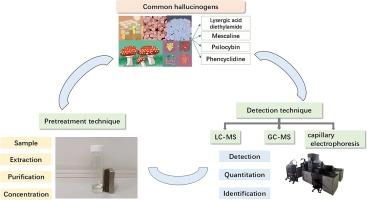Hallucinogens in different complex samples: Recent updates on pretreatment and analysis methods since 2017
IF 4.9
2区 化学
Q1 CHEMISTRY, ANALYTICAL
引用次数: 0
Abstract
Hallucinogens, a category of novel psychoactive substances that can be either natural or synthetic, have the potential to induce distortions in the perception of time and space and can result in dissociative thinking, thereby posing a considerable risk to public safety and societal well-being. Consequently, the development of rapid, accurate, and highly sensitive analytical methods for hallucinogens is of paramount importance for safeguarding public health and ensuring social stability. This paper provides a comprehensive review of the current research on the pretreatment and determination methods for hallucinogenic agents in different matrices since 2017. Pretreatment techniques encompass liquid–liquid extraction, liquid phase microextraction, solid phase extraction, and solid phase microextraction, among others. Analytical methodologies include liquid chromatography-based techniques, gas chromatography-based techniques, supercritical fluid chromatography, and sensor-based approaches, among others. This study also examines the advantages and disadvantages, applications, and developmental trends of various pretreatment and detection methods, thereby offering a valuable reference for future research endeavors.

不同复杂样品中的致幻剂:2017 年以来预处理和分析方法的最新进展
致幻剂是一类新型精神活性物质,可以是天然的,也可以是人工合成的,有可能引起时间和空间感知的扭曲,并导致分离性思维,从而对公共安全和社会福祉构成相当大的风险。因此,开发快速、准确和高灵敏度的致幻剂分析方法对于保障公众健康和社会稳定至关重要。本文全面回顾了2017年以来不同基质中致幻剂的前处理和测定方法的研究现状。前处理技术包括液液萃取、液相微萃取、固相萃取和固相微萃取等。分析方法包括基于液相色谱法的技术、基于气相色谱法的技术、超临界流体色谱法和基于传感器的方法等。本研究还探讨了各种前处理和检测方法的优缺点、应用和发展趋势,从而为未来的研究工作提供了宝贵的参考。
本文章由计算机程序翻译,如有差异,请以英文原文为准。
求助全文
约1分钟内获得全文
求助全文
来源期刊

Microchemical Journal
化学-分析化学
CiteScore
8.70
自引率
8.30%
发文量
1131
审稿时长
1.9 months
期刊介绍:
The Microchemical Journal is a peer reviewed journal devoted to all aspects and phases of analytical chemistry and chemical analysis. The Microchemical Journal publishes articles which are at the forefront of modern analytical chemistry and cover innovations in the techniques to the finest possible limits. This includes fundamental aspects, instrumentation, new developments, innovative and novel methods and applications including environmental and clinical field.
Traditional classical analytical methods such as spectrophotometry and titrimetry as well as established instrumentation methods such as flame and graphite furnace atomic absorption spectrometry, gas chromatography, and modified glassy or carbon electrode electrochemical methods will be considered, provided they show significant improvements and novelty compared to the established methods.
 求助内容:
求助内容: 应助结果提醒方式:
应助结果提醒方式:


